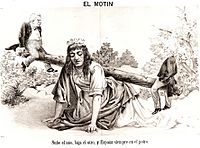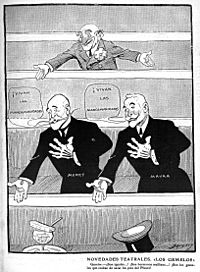Turno facts for kids
In Spain during the late 1800s and early 1900s, there was a special political system called El Turno Pacífico (which means "The Peaceful Turn"). This was an informal agreement between the two biggest political parties. It made sure that the Conservative Party and the Liberal Party would take turns being in charge of the government. This system helped keep things calm and stable in Spain for many years.
Contents
How the Peaceful Turn Worked
Under the Turno Pacífico system, the king would first choose which party would form the new government. After that, this new government would then "arrange" the election. This process was called encasillado, meaning "pigeonholing," and it made sure that the chosen party would win the election.
A key part of this system involved a chain of command:
- The Minister of the Interior (a government official)
- Provincial civil governors (leaders in different regions)
- Local bosses, known as caciques
These caciques were powerful people in their local areas. They would tell the people who depended on them how to vote, making sure the "right" party won. A similar system existed in Portugal and was called rotativismo.
Why the Peaceful Turn Was Created
The Turno Pacífico was started by a politician named Antonio Cánovas del Castillo. Its main goal was to bring stability to Spain. Before this system, Spain had faced almost a century of political problems and many civil wars.
The system made sure that the two main parties, the Conservative Party and the Liberal Party, kept power by taking turns. Both of these parties supported the king and the monarchy. They were seen as different groups within the "governing class" – the people who ran the country.
This system worked well until 1898. It even continued after the death of King Alfonso XII in 1885. However, after 1898, it became harder to manage. This was because the main parties started having disagreements among themselves, and more people began to get involved in politics.
When the Peaceful Turn Ended
Even though Spain's system was inspired by the United Kingdom, it wasn't truly democratic. Until about 1914, the election results were mostly decided beforehand, so what ordinary people thought didn't really change the outcome.
Growing opposition to this system became clear after Spain lost the Spanish–American War. There was a lot of instability in Spain between 1918 and 1919. Some attempts were made to bring back the Turno Pacífico between 1920 and 1923. However, the system finally ended for good when General Miguel Primo de Rivera led a military takeover in September 1923.
Election Results During the Peaceful Turn
The table below shows how the two main parties performed in elections while the Turno Pacífico system was in place. It highlights which party won the most seats (Deputies) in each election.
| Deputies | ||||
| Date | % non-voters | Conservatives | Liberals | Others |
| 23 January 1876 | 45 | 333 | 27 | 31 |
| 20 April 1879 | 293 | 56 | 43 | |
| 20 August 1881 | 29 | 39 | 297 | 56 |
| 27 April 1884 | 28 | 318 | 31 | 43 |
| 4 April 1886 | 56 | 278 | 58 | |
| 1 February 1891 | 253 | 74 | 72 | |
| 5 March 1893 | 44 | 281 | 75 | |
| 12 April 1896 | 269 | 88 | 44 | |
| 27 March 1898 | 68 | 266 | 67 | |
| 16 April 1899 | 35 | 222 | 93 | 76 |
| 19 May 1901 | 33 | 79 | 233 | 89 |
| 26 April 1903 | 234 | 102 | 67 | |
| 10 September 1905 | 115 | 229 | 60 | |
| 21 April 1907 | 33 | 252 | 69 | 83 |
| 8 May 1910 | 17 | 102 | 219 | 83 |
| 8 March 1914 | 24.7 | 188 | 85 | 135 |
| 9 April 1916 | 20.3 | 88 | 230 | 91 |
See also
 In Spanish: Turnismo para niños
In Spanish: Turnismo para niños



